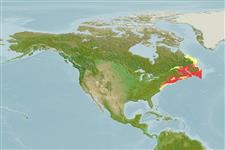>
Perciformes/Cottoidei (Sculpins) >
Agonidae (Poachers) > Hemitripterinae
Etymology: Hemitripterus: Greek, hemi = half + Greek, tres, tria = three + Greek, pteron = wing, fin (Ref. 45335).
More on author: Gmelin.
Environment: milieu / climate zone / depth range / distribution range
экология
морской демерсальный; пределы глубины 2 - 180 m. Temperate; ? - 16°C (Ref. 27549); 58°N - 36°N, 76°W - 50°W
Northwest Atlantic: Labrador in Canada to Chesapeake Bay in USA.
Size / Вес / Возраст
Maturity: Lm ? range ? - ? cm
Max length : 68.0 cm TL самец/пол неопределен; (Ref. 49746); наибольший вес (опубликованные данные): 3.2 kg (Ref. 7251)
Inhabit rocky or hard bottom and is a voracious eater. Food includes crustaceans, mollusks, sea urchins, fishes such as herring, sand lance and silver hake, and any bottom invertebrates that are available. When taken out of the water the belly becomes inflated so that when returned to the water they are unable to submerge. Adults attach their eggs near the base of a sponge to use as a spawning bed (Ref. 34819, 41075).
Life cycle and mating behavior
половая зрелость | размножение | нерест | икра | Fecundity | личинки
Adults attach their eggs near the base of a sponge to use as a spawning bed (Ref. 34819, 41075).
Robins, C.R. and G.C. Ray, 1986. A field guide to Atlantic coast fishes of North America. Houghton Mifflin Company, Boston, U.S.A. 354 p. (Ref. 7251)
Статус Красного Списка МСОП (Ref. 130435: Version 2024-1)
Угроза для людей
Harmless
Использование человеком
объект спортивного рыболовства: да; наживка: occasionally
дополнительная информация
инструменты
Специальные отчеты
Скачать в формате XML
ресурсы в Интернет
Estimates based on models
Preferred temperature (Ref.
123201): 0.5 - 10.2, mean 3.8 °C (based on 130 cells).
Phylogenetic diversity index (Ref.
82804): PD
50 = 0.6289 [Uniqueness, from 0.5 = low to 2.0 = high].
Bayesian length-weight: a=0.00794 (0.00578 - 0.01091), b=3.19 (3.10 - 3.28), in cm total length, based on LWR estimates for this species (Ref.
93245).
Trophic level (Ref.
69278): 4.5 ±0.5 se; based on diet studies.
устойчивость к внешним воздействиям (Ref.
120179): очень низкий, минимальное время удвоения популяции более 14 лет (Preliminary K or Fecundity.).
Fishing Vulnerability (Ref.
59153): Moderate to high vulnerability (47 of 100).
Nutrients (Ref.
124155): Calcium = 32.1 [17.3, 64.8] mg/100g; Iron = 0.341 [0.174, 0.650] mg/100g; Protein = 17.2 [15.9, 18.5] %; Omega3 = 0.575 [0.254, 1.525] g/100g; Selenium = 17.2 [8.4, 40.8] μg/100g; VitaminA = 24.2 [7.4, 79.7] μg/100g; Zinc = 0.423 [0.300, 0.618] mg/100g (wet weight);
